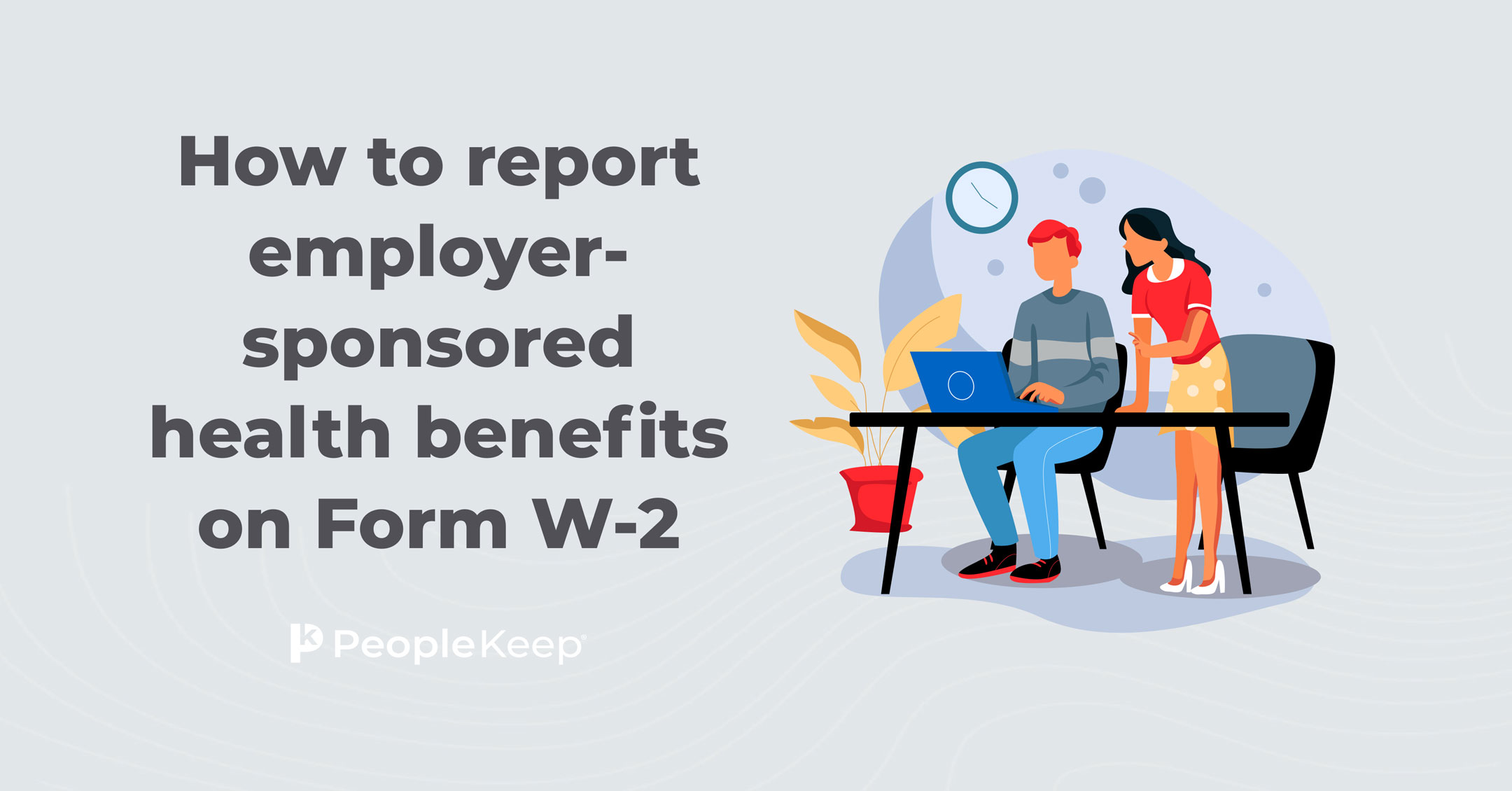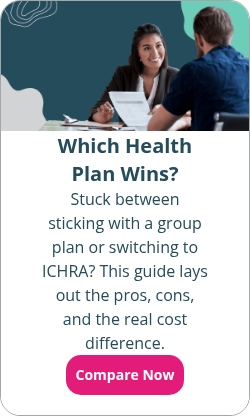What is an HRA?
By Holly Bengfort on October 17, 2024 at 10:00 AM
Offering a health benefit is a big financial decision for employers and business owners alike. You have to consider things like cost, flexibility, and medical services covered. While traditional health benefits options may seem out of reach, a more flexible and increasingly popular option is available: the health reimbursement arrangement (HRA).
In this article, we'll go over what HRAs are, how they work, and how they differ from other health benefit options.
In this blog post, you'll learn the following:
- How HRAs allow you to provide tax-free reimbursement to your employees for individual insurance premiums and other out-of-pocket medical costs.
- How HRAs compare to alternative health coverage options like employer-funded group health plans and HSAs.
- The types of HRA available.
What are HRAs?
An HRA, sometimes mistakenly called a health reimbursement account, is an IRS-approved health benefit. In many cases, it reimburses employees for individual health insurance premiums, but some HRAs can only be used to cover out-of-pocket healthcare expenses or excepted benefits. An HRA is an employer-funded benefit, which means there are no employee contributions.
An HRA isn't health insurance. Instead, employers offer employees a monthly allowance of tax-free money for health-related expenses. Employees choose the medical services and insurance plans that suit them, and employers reimburse them up to a set limit.
HRAs are an excellent way to provide a well-rounded health benefit that meets your employees' unique needs. They're an especially budget-friendly option for small businesses that can't afford traditional group health insurance coverage.
The types of HRA benefits available include:
- Qualified small employer HRA (QSEHRA)
- Individual coverage HRA (ICHRA)
- Group coverage HRA (GCHRA), also known as an integrated HRA
- Excepted benefit HRA (EBHRA)
- Dental/vision HRA
- Retiree HRA
Keep in mind that employers still have a lot of flexibility when designing each benefit, which is one of the most appealing advantages of an HRA.
How does an HRA work?
The way HRAs work is simple. HRAs are unfunded notional accounts with no cash value. This means that employers don’t release HRA funds until they approve reimbursements. Through HRAs, employers reimburse employees directly after they incur an eligible healthcare expense.
Employer contributions are tax-deductible and payroll tax-free. The money employees receive is also free of income taxes.
Although each HRA is different, they follow the same five-step structure:
- The business sets the allowance amount. Employers decide the maximum amount of tax-free money they want to offer employees for their eligible healthcare expenses. Some HRAs allow employers to customize allowances by age, family status, or employee class.
- Employees make purchases. Employees can buy healthcare products and medical services that suit their needs. This may include individual health insurance plans.
- Employees submit proof of the expense incurred. Employees submit receipts for eligible health expenses to get reimbursed. This documentation is usually given in the form of a receipt or invoice.
- The business reviews employee documentation. The employer reviews employees' documentation for three things: the service or product, the date of the service or sale, and the amount incurred. If it's an eligible expense with documentation that meets these criteria, the expense is approved.
- The business reimburses employees. After approving the expense, the company reimburses employees from their set allowance amount. Once an employee reaches their allowance, they can't exceed it.
If you'd like to roll over the unused money in an HRA, the option varies by plan type. Depending on your HRA, unused funds can roll over from month to month or year to year.
For example, QSEHRAs may roll over from month to month or year to year. However, any annual rollover must still adhere to the QSEHRA's annual limit for allowances.
But with integrated HRAs, employers can allow unused amounts to accrue monthly and annually. They also have the option not to allow an annual rollover.
If you're offering an HRA with PeopleKeep, only monthly rollover is permitted. This means that employers can keep unused allowances at the end of the plan year.
How is an HRA different from a health savings account?
HRAs are often confused with health savings accounts (HSAs), but they have differences. An HSA is a tax-advantaged health account for employees covered by an HSA-qualified high deductible health plan (HDHP).
Employees can use it on qualified out-of-pocket costs, such as:
- Dental expenses
- Vision expenses
- Prescription drugs
- Over-the-counter medications
The main difference between the two health benefits is that the employer owns the HRA, and the employee owns the HSA. This means if an employee with an HRA leaves an organization, the unused HRA funds stay with the employer, similar to a flexible spending account (FSA).
Another significant difference is how you fund the two accounts. The money in an HRA is provided solely by the employer. With an HSA, both the employer and the employee can contribute to the account. Additionally, HSAs are pre-funded while HRA allowances are only paid out after an eligible expense has been incurred and submitted for reimbursement.
Unlike certain HRAs, like an integrated HRA, HSAs have annual contribution limits.
Employees can’t use their HSA on most insurance premiums.
What expenses qualify for reimbursement under an HRA?
HRAs can reimburse any qualified expense under IRS Section 213(d) of the Internal Revenue Code. You can find a list of these expenses in IRS Publication 502 and the CARES Act.
Because many HRAs can reimburse both medical expenses and health insurance premiums, this is a valuable employee benefit that can help lower your team's overall healthcare cost.
Different HRAs may restrict certain types of items from reimbursement. Some businesses choose to provide a premium-only HRA, for example, which only reimburses health insurance premiums.
What are the different types of HRAs?
HRAs have undergone many changes over the years and continue to grow in popularity. Now, businesses can choose between six different HRAs to offer their employees.
Let's briefly go over each option below to give you a better idea of how they work.
1. Qualified small employer HRA (QSEHRA)
The QSEHRA is a popular stand-alone health benefit for small businesses. It's for employers with fewer than 50 full-time equivalent employees (FTEs) who don't offer a group plan. With the QSEHRA, employers can set a monthly benefit allowance for employees according to their individual or family status.
QSEHRAs have contribution limits that the IRS sets each year. Allowance amounts typically roll over from month to month. You must offer a QSEHRA to all full-time W-2 employees. Additionally, businesses can choose to offer it to part-time employees as long as they receive the same allowance as full-time employees. You can offer larger allowances to employees with families.
Employees must have health insurance that provides minimum essential coverage (MEC) to participate in a QSEHRA. This can include individual health insurance or coverage through a spouse’s or parent’s traditional group health plan. Reimbursements from this benefit are free from employee income tax.
QSEHRA highlights:
- Only for organizations with 50 or fewer FTEs
- Organizations can’t offer a group plan
- The IRS sets annual allowance caps
2. Individual coverage HRA (ICHRA)
The ICHRA works much like the QSEHRA, but it's available to organizations of all sizes. It comes with no contribution limits and allows businesses to offer different allowance amounts based on 11 employee classes. This allows employers to categorize employees into groups and makes it easier to customize benefits.
However, the ICHRA is only available to employees with an individual health insurance policy. Therefore, employees covered by a family member's group policy or an alternative like Medi-Share can't participate in the benefit.
The Affordable Care Act requires organizations with 50 or more FTEs to offer health insurance. Offering an affordable ICHRA allowance can help you satisfy the employer mandate.
ICHRA highlights:
- For organizations of all sizes
- Employers can customize allowances and benefit eligibility with employee classes
- No contribution limits
3. Group coverage HRA (GCHRA)
The group coverage HRA (GCHRA), or integrated HRA, is available to businesses of all sizes. Organizations must offer a group health insurance policy. In this case, only company employees who opt into the health plan can take advantage of the HRA.
With an integrated HRA, employers can offer monthly allowances for employees to pay for any qualified health expense. This includes those their group health insurance policy doesn’t fully pay for. Common types of expenses that are eligible for reimbursement with an integrated HRA include copays, coinsurance, and expenses employees pay before their deductible is met. You can’t reimburse premiums with a GCHRA.
Businesses of all sizes can offer the integrated HRA. There are no allowance limits, and, like the ICHRA, employers can offer different allowance amounts based on employee classes.
GCHRA highlights:
- It supplements traditional group health insurance coverage
- No contribution limits
4. Excepted benefit HRA (EBHRA)
Much like the GCHRA, an EBHRA is used in conjunction with a group health plan. While employers typically use the integrated HRA to reimburse employees for out-of-pocket expenses, employers can use the excepted benefit HRA to reimburse employees for excepted benefits.
Companies of any size may offer an EBHRA, which covers “excepted” benefits only.
Excepted benefits include:
- Copays
- Deductibles
- Monthly premiums for vision and dental insurance
EBHRAs can also cover COBRA insurance, long-term care, and short-term care. You must offer an EBHRA to every employee on the same terms.
Like the QSHERA, the IRS adjusts EBHRA annual contribution limits yearly for inflation.
5. Retiree HRA
The retiree HRA is available solely to a business's retired employees. Businesses of all sizes can offer this HRA. It has no allowance caps or group health insurance requirements, and annual rollover is permitted if the employer allows it.
6. Dental/vision HRA
Employers who also want to provide dental and vision benefits to employees can utilize an HRA to reimburse only these expenses. These types of limited HRAs have a very narrow focus and are often paired with HSA to reimburse employees for expenses exempt from the HSA deductible requirement. You can do this by modifying an EBHRA or GCHRA.
If you're looking to implement an HRA in conjunction with your group health plan, but want to cover fewer out-of-pocket expenses, then a dental/vision HRA is a better choice than the more expansive integrated HRA.
HRA comparison chart
Understanding how each HRA functions can be confusing. To make their differences clearer, the chart below explains how most HRAs compare to each other.
|
Type of health plan |
Qualified small employer HRA (QSEHRA) |
Individual coverage HRA (ICHRA) |
Group coverage HRA (GCHRA) |
Excepted benefit HRA (EBHRA) |
|
Employer size restrictions |
The QSEHRA is only available to employers with fewer than 50 FTEs. |
None. |
None. |
None. |
|
Group coverage requirements |
You can't offer a QSEHRA if you also offer a group plan. |
You can’t offer the same class of employees an ICHRA and a group plan. However, you can offer different classes and different benefits. |
You must offer a GCHRA alongside traditional health coverage. |
You must offer a group health insurance plan to your employees. However, employees don’t need to participate in the plan to use their EBHRA. |
|
Eligible employees |
All W-2 full-time employees are automatically eligible for the QSEHRA. Employers can include W-2 part-time employees as long as they offer the same allowance amount as full-time employees. Employees must have health insurance with MEC. |
The ICHRA is only available to employees with an individual health insurance plan. |
The GHCRA is only available to employees also covered by the company's group health insurance plan. |
The EBHRA is available to all employees you offer a group health plan to, even if they decline to participate in the group plan. |
|
Maximum annual contribution limits |
QSHERA annual contribution limits are set by the IRS. For 2026, this is $6,450 for self-only employees and $13,100 for employees with a family. |
None. |
None. |
The IRS sets annual EBHRA contribution limits. For 2026, this is $2,200. |
|
Contribution guidelines |
With the QSEHRA, businesses can offer different allowance amounts based on whether the employee is an individual or has a family. |
With the ICHRA, businesses can offer different allowance amounts to different classes of employees based on job criteria. They can also differ allowances by family status. |
With the GCHRA, businesses can offer different allowance amounts to different classes of employees based on job criteria. |
With an EBHRA, businesses can differ allowances by employee class. |
|
Rollover guidelines |
Employer funds can roll over from month to month and year to year. However, total QSEHRA amounts can't exceed the annual maximum allowance limit. |
Employer funds can roll over month to month and year to year. |
Employer funds can roll over month to month and year to year. |
Employer funds can roll over month to month and year to year. |
Is an HRA a good idea for my business?
An HRA is worth considering if you're looking for a simple way to offer an affordable and flexible health benefit to employees.
HRAs provide the following advantages for employers:
- Better cost control with the ability to set a budget-friendly allowance.
- Tax benefits like tax-deductible employer contributions and payroll tax exemptions.
- Customizable benefit design to best suit the organization's and employees' needs.
- Provides lower risk than other health benefit options by not paying out until reimbursement.
- Helps employers attract and retain talent by boosting your competitive employee benefits package.
Check if you meet the HRA eligibility requirements to see if it's right for your business. For example, to offer a QSEHRA, you must have fewer than 50 FTEs and no group health insurance policy.
Next, determine your budget. If you can afford a traditional group health plan, you may choose an integrated HRA to supplement it. However, if you can't afford a group health insurance plan, a QSEHRA is a strong choice.
Finally, consider whether the HRA would suit your employees. For example, if your small business has many employees on a family member's insurance policy or who live out of state, the QSEHRA is an excellent solution. However, if you want to set different allowance amounts, an ICHRA would be a better fit.
Generally, the more diverse your employees and the more budget-conscious your business, the better fit an HRA can be.
Should employers use an HRA administrator?
If you want to save yourself time and money, yes. Companies offering an HRA should always use an HRA administrator. HRA administration software features make real-time monitoring of HRA liabilities, reimbursement of benefits, and utilization easy.
Organizations can choose to self-administer their HRA, but using an HRA administration platform like PeopleKeep to perform claim reviews, provide customer support, and generate your plan documents can reduce potential compliance complications and HIPAA privacy violations.
If you want to offer a QSEHRA or ICHRA, your employees can even shop for health insurance right from their PeopleKeep dashboard. We make offering and administering an HRA simple for small businesses.
In fact, PeopleKeep allows small businesses to spend ten minutes a month or less administering health benefits to their employees, leaving employers more time to focus on running their company.
Conclusion
Health reimbursement arrangements are cost-effective health benefits. With an HRA, employers can stick to their budgets while helping employees cover their medical expenses using pre-tax dollars.
Determining which HRA is the best fit for your employee benefits package depends on factors like company size and whether or not you have group health insurance coverage. However, for many employers, the flexibility an HRA offers is the primary motivator. Ready to find your perfect HRA match? PeopleKeep can help!
This article was originally published on December 31, 2019. It was last updated on October 20, 2025.
Check out more resources
See these related articles

How to report employer-sponsored health benefits on Form W-2
Unsure how to report employer-sponsored health benefits on your Form W-2? This blog has clear explanations and examples to help you navigate the process.

Health insurance reimbursements: What are the options?
Explore your options for health insurance reimbursement. Understand what insurance reimbursement means and how HRAs can support employees.

What is healthcare reimbursement?
Looking to reimburse your employees for their healthcare expenses? Learn everything you need to know about healthcare reimbursement.



